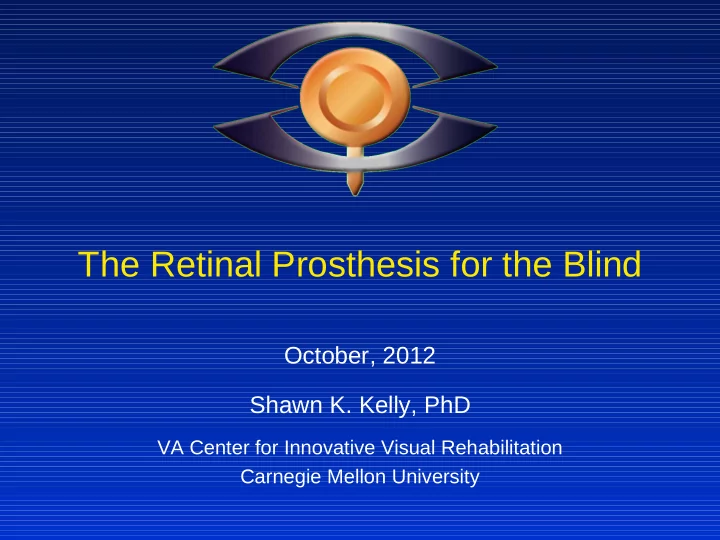

The Retinal Prosthesis for the Blind October, 2012 Shawn K. Kelly, PhD VA Center for Innovative Visual Rehabilitation Carnegie Mellon University
The Retinal Prosthesis An electronic implantable device to restore functional vision to patients with certain forms of blindness, primarily retinal degenerative diseases. The device works by stimulating nerves in the visual system based on an image from an external camera.
Anatomy of the Eye
Anatomy of the Retina Inside/ Front Direction of Light Outside/ Back
Sending Images to the Brain
Degenerative Diseases of the Outer Retina • Age-related Macular Degeneration (AMD) – Loss of photoreceptors in macula (center), working outward – Strikes at age 60-80 with increasing incidence – May take decades to go blind – 2 (?) million cases in US, tens of millions worldwide
Degenerative Diseases of the Outer Retina • Retinitis Pigmentosa (RP) – Loss of photoreceptors in periphery, working inward – Genetic, strikes at age 15-60 – Typically a decade or less to go blind – 100,000 cases in US, 1.7M worldwide
Living with RP
The Boston Retinal Implant • Electronic prosthesis to restore functional vision to patients with retinitis pigmentosa and age-related macular degeneration • 20-year collaboration: MIT, MEEI, VA, Cornell, Carnegie Mellon, and others
Subretinal Implant Placement Inside/ Front Direction of Light Outside/ Back
Retinal Prosthesis Function • Electrically stimulates ganglion nerves based on an external camera image Power And Data Transmission Image Processing
Other Visual Prostheses Epiretinal Cortical
Visual Prosthesis Research Worldwide Retina Sub Retina Epi Optic Nerve Cortical
Challenges • Surgical – Place electrode array safely and securely – Place electronics where they won’t cause damage • Microfabrication – Electrode materials that can safely deliver needed charge but not physically damage tissue – Water-tight packaging of electronics • Electrical Engineering – Deliver balanced electrical current to electrodes – Wirelessly deliver power and image data to implant • Image Processing – Intelligently downsample camera images to 256 pixels – Convey saliency, maximum information about environment
Short-term Human Proof-of-concept Trials • 1998 – 2000, Surgical trials on six volunteers • Epiretinal stimulation for a few hours • Reported spots, lines, not complex shapes Rizzo, et al. IOVS, 2003 Rizzo et al. IOVS, 2003
Portable, 100-channel Neural Stimulator
Short-term Human Proof-of-concept Trials Video - surgery
Short-term Human Proof-of-concept Trials Video - clouds
Short-term Human Proof-of-concept Trials Video - spots
What We Learned • This concept works – patients can see spots and lines, distinguish from control • We need to develop a chronic implant to allow patients to learn • A number of new technologies needed to be developed for chronic implantation
Wireless Power and Data Power and data are delivered by inductively coupled coils via magnetic fields
Miniaturize: Integrated Circuit Design Custom chip design is labor-intensive, but necessary given our size and power restrictions Kelly, et al. IEEE ISSCC, 2004 Theogarajan et al. IEEE ISSCC, 2006 Kelly, et al. IEEE TBioCAS, 2011 Theogarajan IEEE JSSC, 2008
First-Generation Implant • Implanted in 3 minipigs for up to 10 months in 2008 • Wireless power and data telemetry • Coated in silicone – viable for many months, not decades Shire, et al. IEEE TBME, 2009
Improvements to First Generation Implant • Hermetic barrier to protect circuits • Larger telemetry coils • Easier surgical access for electrode insertion
Second Generation Implant Ab externo approach • Electrode array enters the space under the retina through the scleral wall of the eye.
Hermetic Titanium Case • Ceramic 19-pin hermetic feedthrough • Curved titanium case • Laser-welded top and bottom lids
Sputtered Iridium Oxide Film Electrodes • Higher charge capacity • 1 to 6 mC/cm 2 • Pt is limited to 100 µC/cm 2 • But the Shannon Limit is still in effect!
Prototype Implant
In vivo Results • • Recorded artifact of current Waveform is measured at pulses from cornea – shows implant and telemetered out implant was working • Noisy, but you can see the step-ramp components, and variation of voltage with current Kelly, et al. IEEE ISABEL, 2009 Kelly, et al. IEEE TBME, 2011 Kelly, et al. IEEE EMBC, 2009 Kelly, et al. BSPC, 2011
Third Generation Prosthesis • Hundreds of channels (>256) • Smaller hermetic case • Stimulator chip and electrode array under development
Image Processing
Future Research • Finish 256+-channel retinal prosthesis, prepare for FDA clinical trials • Design external camera system, portable telemetry system, etc. • Image processing to convey maximum information with 256 pixels.
The Boston Retinal Implant Project Engineering Medicine and Biology • • John L. Wyatt, PhD (MIT) Joseph F. Rizzo, MD (VA, MEEI) • Douglas B. Shire, PhD (VA, Cornell) • Jinghua Chen, MD, PhD (MEEI) • • Shawn K. Kelly, PhD (VA, CMU) Hank Kaplan, MD (Louisville) • • Ashwati Krishnan, MS (CMU) Vasiliki Poulaki, MD (MEEI) • • Marcus Gingerich, PhD (VA, Cornell) Shelley Fried, PhD (VA, MGH) • • Attila Priplata, PhD (VA, MIT) Ralph Jensen, PhD (VA) • • William Drohan, MS (VA, MIT) Ofer Ziv, PhD (VA, MIT) • • Bruce McKay, BS (MEEI, Cornell) Lotfi Merabet, OD, PhD (VA) • Oscar Mendoza (MIT) • Carmen Scholz, PhD (Alabama) • Stuart Cogan, PhD (EIC Biomedical) • William Ellersick, PhD (Analog Circuit Works) • Sonny Behan (Sonny Behan Consulting) Thanks to: Department of Veterans Affairs, MOSIS, NIH, NSF, DoD, Catalyst Foundation
Discussion
Recommend
More recommend